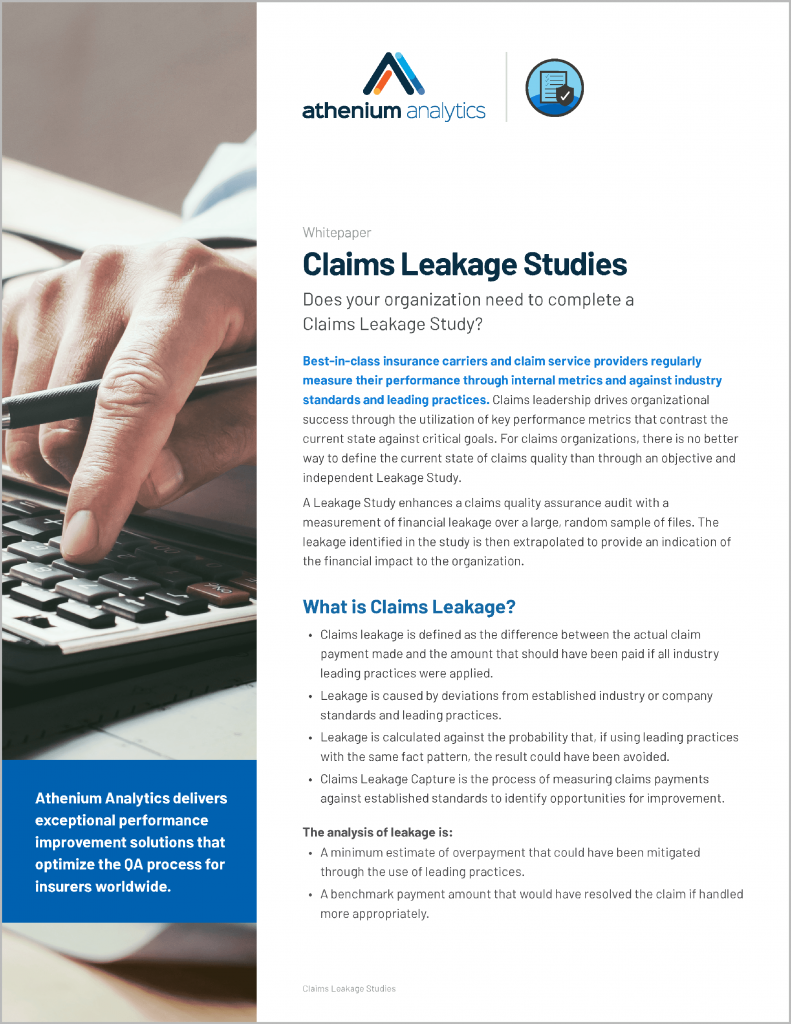Is your QA software keeping up with your claims technology?
At Athenium Analytics, we’re obsessed with optimizing the underwriting and claims processes for insurance carriers. Our powerful SaaS tools are trusted by some of the world’s largest insurers, providing insights like weather claims verification, aerial imagery property analysis, and risk scoring for natural hazards. But no matter how many insurtech tools that risk managers have at their disposal, unconscious biases and procedural errors still affect even the highest performers. As insurers adopt new technology to streamline their claims processes (like automation and touchless claims), they must also continue to invest in their claims audit tools.
19 years of insurance QA insights
 Our teamthink insurance audit software has been providing sophisticated tools for claims and underwriting reviews since 2001. Consulting with insurance (and reinsurance) companies for almost two decades has provided valuable insights into what separates good insurers from great ones. One thing we’ve learned is that most Fortune 500 insurance companies understand just how essential claims reviews and operational audits are to their financial performance. Sure, they have the resources to staff large internal audit teams and meticulously review claims and underwriting files at a moment’s notice. But it’s not just about staffing. Great insurance companies understand how devastating claims leakage can be to their bottom line—and because of that, they make quality assurance a top priority.
Our teamthink insurance audit software has been providing sophisticated tools for claims and underwriting reviews since 2001. Consulting with insurance (and reinsurance) companies for almost two decades has provided valuable insights into what separates good insurers from great ones. One thing we’ve learned is that most Fortune 500 insurance companies understand just how essential claims reviews and operational audits are to their financial performance. Sure, they have the resources to staff large internal audit teams and meticulously review claims and underwriting files at a moment’s notice. But it’s not just about staffing. Great insurance companies understand how devastating claims leakage can be to their bottom line—and because of that, they make quality assurance a top priority.
There are high-quality insurers and reinsurers of every size. But typically, as DPW decreases, so too does the QA staffing and priority of claims reviews. The irony is that small and medium-sized insurers have the most to gain by optimizing their claims and underwriting review processes. For some smaller carriers, a few basis points can mean the difference between ending the year in the red or the black. That’s why Athenium Analytics is on a mission to promote insurance QA best practices to every insurer, regardless of size, location or specialty.
Investing in your claims audit & review technology
Many insurers have been using the same QA tools for years. Excel spreadsheets and custom in-house databases may seem feasible for reviewing claims and underwriting files on a small scale. But as volume of audits and reporting requirements increase, makeshift tools become increasingly difficult to manage. When every step of the claims review process requires a small hack, trick or workaround to get the data you need, the process becomes unsustainable. As claims departments add the newest technology to increase their volume and efficiency, the QA team and they tools they use —no matter the size—is left struggling to keep up.
So the question is, what is the current state of your QA and claims audit process? Are you investing in QA software that scales with your organization? More importantly, how much money are you losing every year to claims leakage?
What is insurance claims leakage?
Claims leakage is the amount of money paid out or lost because of oversights and inefficiencies in the insurance claims process. It is calculated by finding the difference between claim amounts actually paid versus the amounts that should have paid if all the correct data and guidelines were correctly applied. Generally, claims leakage is caused by fundamental issues in the claims process and workflow that can be correctly with better tools and oversight. Teams need access to key metrics, historical benchmarks, and industry best practices. And quality assurance departments need customizable tools to them access, sample and evaluate records in an objective way.
The teamthink claims review tool has been developed over 18 years using insights from the world’s most effective insurance teams. How does your current QA software stack up? Are you truly able to measure claims leakage using your current review system?
It’s time to conduct a claims leakage study
There is no better way to assess the current state of claims quality than by performing an objective claims leakage study. A leakage study provides valuable quality assurance insights by measuring financial leakage over a large, random sample of files. The leakage identified in the study’s sample is then extrapolated to provide an indication of the financial impact to the organization. Athenium Analytics has worked with countless insurers, reinsurers, MGAs, and agencies of every size to help identify, measure and mitigate leakage. We’ve created a claims leakage whitepaper to help insurance executives learn more about claims leakage. The topics include:
- What is a claims leakage study?
- When is a good time to conduct a leakage study?
- What are the components of a good leakage study?
- What team members should be involved?
- What is the process and technology needed?
- What kind of results might you see?
Download our insurance claims leakage whitepaper
Click the image below to access the whitepaper now.
View all Athenium Analytics whitepapers here: https://www.athenium.com/insights/whitepapers/
Want to speak with an insurance QA expert? Contact us today.






